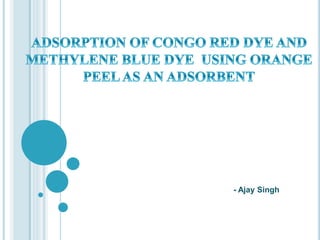ADSORPTION OF CONGO RED DYE AND METHYLENE BLUE DYE USING ORANGE PEEL AS AN ADSORBENT
- 1. - Ajay Singh
- 2. Dyes- ’ü▒ Organic compounds that can provide bright and lasting color to other substances. ’ü▒ Dyes absorb wavelengths in the visible spectrum (400nm-720nm) TYPES NATURAL SYNTHETIC ’ü▒ Used in the textile, leather, paper, rubber, plastic, pharmaceuticals, food industries, etc. ’ü▒ Difficult to biodegrade because of their complex aromatic molecular structure which makes them more stable. ’ü▒ Treatment process involves use of chemicals which lead to secondary pollution.
- 3. Wastewaters Features High BOD High COD Visible Pollutant Hot, alkaline and contain high amounts of dissolved solids Harmful effects Toxic Carcinogenic Mutagenic Teratogenic Retards photosynthetic activity Inhibits growth of aquatic biota Adsorption- Adhesion of atoms, ions, or molecules from a gas, liquid, or dissolved solid to a surface. Types Physisorption (characteristic of weak van der Waals forces) Chemisorption (characteristic of covalent bonding). It may also occur due to electrostatic attraction.
- 4. ADSORBATE ADSORBENT ’ü▒ Congo red dye ’ü▒ Methylene blue dye ’ü▒ Orange peel extract
- 5. Preparation of stock (1g/L) of dyes. Addition of 0.25g absorbent in 25ml sample Removal of sample at different time intervals Calculate percentage removal Colorimetric reading congo red at 497 nm and methylene at 590 nm.
- 6. CONGO RED DYE ADSORPTION METHYLENE BLUE DYE ADSORPTION
- 7. (1) Congo red: The percentage removal was obtained by calculating the difference between initial and final optical density of dye solution at 497nm. Optimum percentage removal was found to be 23.25% at 100mins. Time in minutes Percentage Removal of Congo Red dye 20 5.62 40 10.12 60 14.50 80 18.75 100 23.25
- 8. (2) Methylene blue: The percentage removal was calculated by calculating the difference between initial and final optical density of dye solution at 590nm. Optimum percentage removal was found to be 11.25% at 20mins. Time in minutes Percentage removal of methylene blue dye 2 - 4 0.87 6 1.63 8 3.25 10 1.63 12 2.75 14 3.25 16 7.50 18 7.75 20 11.25 Percentage removal of Methylene Blue dye solution (%)
- 9. The percentage removal of dye from congo red solution by orange peel was found to be 5.62%,10.12%,14.5 %,18.75% and 23.25% at time interval of 20,40,60,80 and 100mins respectively. Congo red Percentage removal was found to be 0.87%,1.63%,3.25 %,1.63%, 2.75%,3.25%,7.50 %,7.75%,11.25% at time interval of 2,4,6,8,10,12,14,16, 18 and 20mins respectively. Methylene blue ’ü▒ Batch absorption method was used for dye absorption study. ’ü▒ Percentage removal of both the dye increases with increase in time. ’ü▒ To try and find various other waste materials to be used as adsorbents. ’ü▒ To test adsorbent activity of other group of azo dyes such as azo violet, Janus green B, Erichrome Black T, etc.










